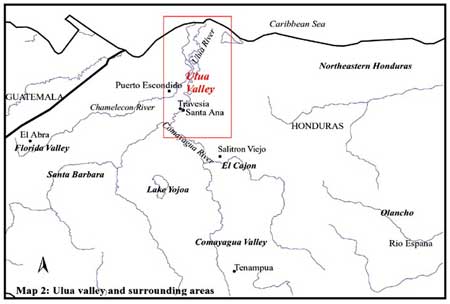
| FAMSI © 2003: Christina Luke |
||
Ulúa-Style Marble Vase Project: Dissemination of Results
Introduction The fertile alluvium of the Ulúa valley in northwestern Honduras covers ca. 2,400 kilometers and includes a vast range of environmental conditions and a rich and varied flora and fauna including deer, tapir, monkeys, quetzals, and felines. Shell and other marine resources are available in the north where the Ulúa River meets the Caribbean. A local obsidian source can be found on the southwestern flank of the valley and jade from the Motagua valley is located west just over the Honduran-Guatemalan border. The region was particularly known for cacao, among the richest in Mesoamerica according to conquest documents. The Chamelecón, Ulúa, and Comayagua rivers that flow into the valley provide natural routes of communication to Yucatán and the central and southern Maya Lowlands as well as to central, southern, and eastern Honduras and onto lower Central America. This lush valley and its unique geographic position–typically described as the "Maya Frontier"–places the valley in a key location with interaction between the cultures of lower Central America and those of the Maya lowlands. The goal of this project is to understand how one specific object, Ulúa marble vases, functioned in this diverse region during the Late Classic period.
Ulúa marble vases represent a luxury good produced in the valley and exchanged to neighboring regions as well as distant communities in Guanacaste, Costa Rica and the central Maya Lowlands. During the mid-1920s and the 1930s two archaeologists–E.G. Gordon (1920, 1921) and Doris Stone (1938)–turned their attention to these exquisite vases (also see Stone 1972, 1977). Yet, it wasn’t until Anne-Louise Schaffer’s 1992 MFA Houston exhibition–On the Edge of the Maya World–that a more up-to-date investigation was completed. My study builds on these art historical approaches and combines data on settlement patterns, archaeological contexts, stylistic analyses and chemical analyses to explore vessel use and production. The basic theoretical framework is that artifacts representing a high level of skill with a shared iconography, limited distribution, and similar chemical signatures represent luxury items most likely produced in centralized locations by artisans for wealthy patrons (see Ball 1993; Beaudry 19984; Clark 1995; Clark and Perry 1990; Clark and Houston 1998; Costin 1991, 1998; Inomata 2001; Reents-Budet 1994, 1998; Reents-Budet et al. 1994; Reents-Budet et al. 2000). My preliminary results of the vases indicated that the standardized forms, elaborately carved iconography, limited distribution in putative high-status contexts in the valley and outside of the region and the concentration of vases in the central valley at Travesía strongly pointed to centralized production. Petrographic and stable isotope analyses of vases and potential sources were conducted in hopes that the results would confirm decentralized or centralized production and provide a working hypothesis of which sources may have been used for procurement (see Luke and Tykot 2002). These results confirm centralized production. |
||
|
Text links to all pages at this site are available at the FAMSI INDEX |
||

